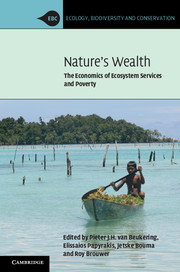Book contents
- Frontmatter
- Contents
- List of contributors
- Acknowledgements
- 1 The economics of ecosystem services and poverty
- Part I Biodiversity-related ecosystem services
- 2 Park–people conflicts, rhino conservation and poverty alleviation in Nepal
- 3 Rural poverty and human–elephant conflicts in Sri Lanka
- 4 Poverty, livelihoods and the conservation of nature in biodiversity hotspots around the world
- Part II Marine-related ecosystem services
- Part III Forest-related ecosystem services
- Part IV Water-related ecosystem services
- Part V Land-related ecosystem services
- Index
- References
3 - Rural poverty and human–elephant conflicts in Sri Lanka
Published online by Cambridge University Press: 05 July 2013
- Frontmatter
- Contents
- List of contributors
- Acknowledgements
- 1 The economics of ecosystem services and poverty
- Part I Biodiversity-related ecosystem services
- 2 Park–people conflicts, rhino conservation and poverty alleviation in Nepal
- 3 Rural poverty and human–elephant conflicts in Sri Lanka
- 4 Poverty, livelihoods and the conservation of nature in biodiversity hotspots around the world
- Part II Marine-related ecosystem services
- Part III Forest-related ecosystem services
- Part IV Water-related ecosystem services
- Part V Land-related ecosystem services
- Index
- References
Summary
Introduction
The conflict between wild elephants and rural farmers is of great concern for wildlife management and rural development in most parts of Asia and Africa. In Sri Lanka, the conflict is at a very acute stage, as revealed by the fact that between 1992 and 2001 a total of 536 people were killed by wild elephants and that elephant mortality has reached a level of more than three elephant losses per week. Habitat destruction caused by illegal human encroachments and settlements, interruption of elephant corridors and scarcity of food and water in the national parks are some of the causes that have led to the increase of the human–elephant conflicts (HEC) in all wildlife regions in Sri Lanka. Rapid economic development in the dry zone of the country led to large-scale deforestation. In addition, the civil war further increased the conflict by forcing elephants to shift from forests and national parks in the north and east to the south and the west. As their habitats are increasingly lost, wild elephants often have no other choice than invading nearby farm fields causing damage to crops, trees, storage, houses and other properties, sometimes also resulting in the loss of human lives. In response, farm households are compelled to retaliate in various ways to protect their crops, including the killing of elephants. As stated by Heffernan (2005), the factors driving HECs are complex and case specific to environmental and social variables. The intensity of the HEC depends on elephant-related parameters such as aggressiveness to post-traumatic stress disorder or propensity to feed on field crops instead of the more difficult to find forest plants. Thus, HECs are created in the interaction between the forest environment and people’s actions such as encroachment and land claims.
Elephant are the largest terrestrial animal on earth and they require approximately 130–300 kg of feed and 100–200 l of water per day (WWF 2002). As their natural habitats become fragmented, elephants move from one forest patch to the other for food and water, travelling about 20–25 km per day. In Asian countries, including Bangladesh, Bhutan, China, Cambodia, India, Indonesia, Laos, Myanmar, Malaysia, Nepal, Sri Lanka, Thailand and Vietnam, elephants are restricted to a few isolated and fragmented populations, a total number of approximately 35 000–50 000 elephants thus being affected by rapid population growth (Santiapillai and Jackson 1990, Sukumar 1989). In fact, 70% of elephant habitats in Asia were lost between 1960–2000 (Wickramasinghe and Santiapillai 2000).
- Type
- Chapter
- Information
- Nature's WealthThe Economics of Ecosystem Services and Poverty, pp. 56 - 73Publisher: Cambridge University PressPrint publication year: 2013



